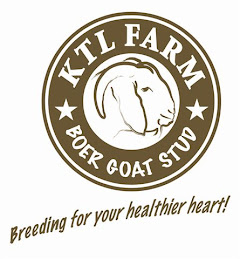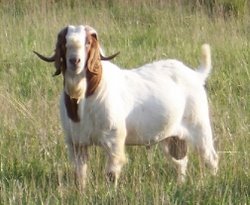| 
Breed Standards of the Boer Goat | The following are the breed standards as drawn up and accepted by the Boer Breeders Association of South Africa. The aim of the breeding standards are to improve the race and to increase the economy value. | | Conformation | HEAD: A strong head with large soft brown eyes and without an untamed look. A strong slightly curved nose, wide nostrils, strong well-formed mouth with will-fitted jaws. Up to two tooth must show a 100% fit. Four tooth olds and older may show 6 mm protrusion. Permanent teeth must cut in the correct anatomical place. The forehead must be prominently curved linking up with the curve of the nose and horns. Horns should be strong, of moderate length and placed moderately apart with a gradual backward curve. Horns have to be as round and solid as possible and coloured darkly. Ears are to be broad, smooth and of medium length hanging downwards from the head. Too short ears are undesirable. Characteristic cull defects: Concave forehead, horns too straight or too flat, pointed jaw, ears folded (lengthwise), stiff protruding ears, too short ears, too long lower jaws, short bottom jaw and blue eyes. | NECK AND FOREQUARTERS: A neck of moderate length in proportion to the length of the body, full and well fleshed and well-joined with the forequarter is essential. The breastbone should be broad with a deep and broad brisket. The shoulder should be fleshy, in proportion to the body and be well-fitted to the withers. The withers should be as broad and as well-filled as possible (not sharp). The front legs should be of medium length and in proportion to the depth of the body. The legs should be strong and well placed, with strong pastern joints and well-formed hoofs which are as dark as possible. Characteristic cull defects: Too long, thin neck, too short neck, shoulders too loose. | BARREL: The ideal is a long, deep broad barrel. The ribs must be well sprung and fleshed, and the loins as well fitted as possible. The goat should have a broad, fairly straight back and must not be pinched behind the shoulders. Characteristic cull defects: Back too concave, too slab sided, too cylindrical or pinched behind the shoulder. | HINDQUARTERS: The Boer Goat should have a broad and long rump, not sloping too much, well fleshed buttocks which are not too flat, and have fully fleshed thighs. The tail must be straight where it grows out of the dock and then swing to either side. Characteristic cull defects: A rump that hangs too much or is too short. A too long shank or flat buttocks. | | LEGS: Emphasis should be placed on the legs which should be strong (of good texture) and well placed. Too fleshy legs are undesirable. Strong legs imply hardiness and a strong constitution, which are absolutely essential characteristics of the Boer Goat. Characteristic cull defects: Knock knees, bandy legs, "koeisekel of regophak." Legs too thin or too fleshy. Weak pasterns and hoofs pointing outwards or inwards. | SKIN AND COVERINGS: A loose supple skin with sufficient chest and neck folds, especially in the case of rams, is essential. Eyelids and hairless parts must be pigmented. The hairless skin under the tail should have 75% pigmentation for stud purposes with 100% pigmentation the ideal. Short, glossy hair is desireable. A limited amount of fur will be tolerated during winter months. Characteristic cull defects: Covering too long and coarse or too furry. | SEXUAL ORGANS: Ewes: Well-formed udder firmly attached with no more than two functional teats on a side. Permissible defects: a) If there is no indication that the teat is separating, but there are two milk openings, this is acceptable. b) Double teats: the front 50% should be split. Rams: Two reasonably large, well formed, healthy and equal sized testes in one scrotum. A scrotum with no larger spit than 5 cm is permissible. The scrotum must be at least 25 cm in circumference. Characteristic cull defects: Bunched, calabash or double teats. Too small testes; a scrotum with more than a 5 cm split. | | QUALITY: This is achieved with short glossy hair and a fine lustre. | | SIZE: The ideal is an average sized, heavy goat with maximum meat production. A desireable relationship between length of leg and depth of body should be achieved at all ages. Lambs should tend to be longer in the leg. Characteristic cull defects: Goats too large or too small (pony). | | COLOURING: The ideal is a white goat with a red head and ears, and fully pigmented. The blaze must be evident. Shadings between light red and dark red are permissible. The minimum requirement for a stud animal is a patch of at least 10 cm in diameter on both sides of the head, ears excluded. Both ears should have at least 75% red colouring and the same percentage pigmentation. The following is permissible for stud purposes: HEAD, NECK AND FORE-QUARTERS: A total red colouring is permissible not further than the shoulder blade and on the shoulder it must exist not lower than level with the chest junction. BARREL, HINDQUARTER AND BELLY: Only one patch not exceeding 10 cm in diameter is permissible. LEGS: The term "legs" is taken to mean that portion below an imaginary line formed by the chest and the underline. Patches with maximum of 5 cm in diameter are permissible. TAIL: The tail must be red, but the red colour may not continue onto the body for more than 2.5 cm. RED HAIR AND COVERING: Very few red hairs are permissible at the 2-tooth stage. PIGMENTATION: Discriminate against too light pigmentation. FLOCK GOAT: A flock goat is a Boer goat which does not comply with the stud standards, but has no cull faults. At least 50% of the colour must be white; the other 50% must be red. Under the tail the flock goat must be at least 25% pigmented Rams may not be more than 25% red. | | EXPLANATION OF BREED STANDARDS: In applying standards, there are many aspects which cannot be fully defined. In such cases the inspector or judge must use his discretion. In spite of the breed standards being clear and to the point, it is nevertheless necessary to supply additional information in respect of certain descriptions. The major part of the body of the goat must be white to make it conspicuous and to facilitate the rounding up of goats in dense terrain. A pigmented skin on the hairless parts, e.g. under the tail, round the eyelids and mouth, etc., is absolutely essential, because it offers resistance to sunburn which may result in cancer. A pigmented skin is also more resistant to skin disease. A loose, supple skin is essential for adaptability to climatic conditions. In South Africa, which is a warm and sunny country, an animal with a loose skin and short hair is better adapted. In addition a skin of this kind provides additional resistance to external parasites. | | GENERAL APPEARANCE AND TYPE: In appearance it is a goat with a fine head, round horns bent backwards, a loose, supple and pleated skin (especially in rams) with different body parts well fleshed and in perfect balance. The ewe must be feminine, wedging slightly to the front, which is a sign of fertility. The ram, nevertheless, appears heavier in the head, neck and forequarters. The upgraded boer goat is an animal with symmetry, with a strong, vigorous appearance and enough quality. In the ewe there is strong emphasis on femininity; in the ram one of masculinity. | | FERTILITY: a) Shows: An ewe must have lambed at 6 tooth age already or must visibly be with young or she will be culled. b) Auctions: 6 tooth or older ewes must visibly be with young or be certified in writing as pregnant by a veterinary surgeon or the ewe will be culled. Certificate to be handed in during inspection. |
|




